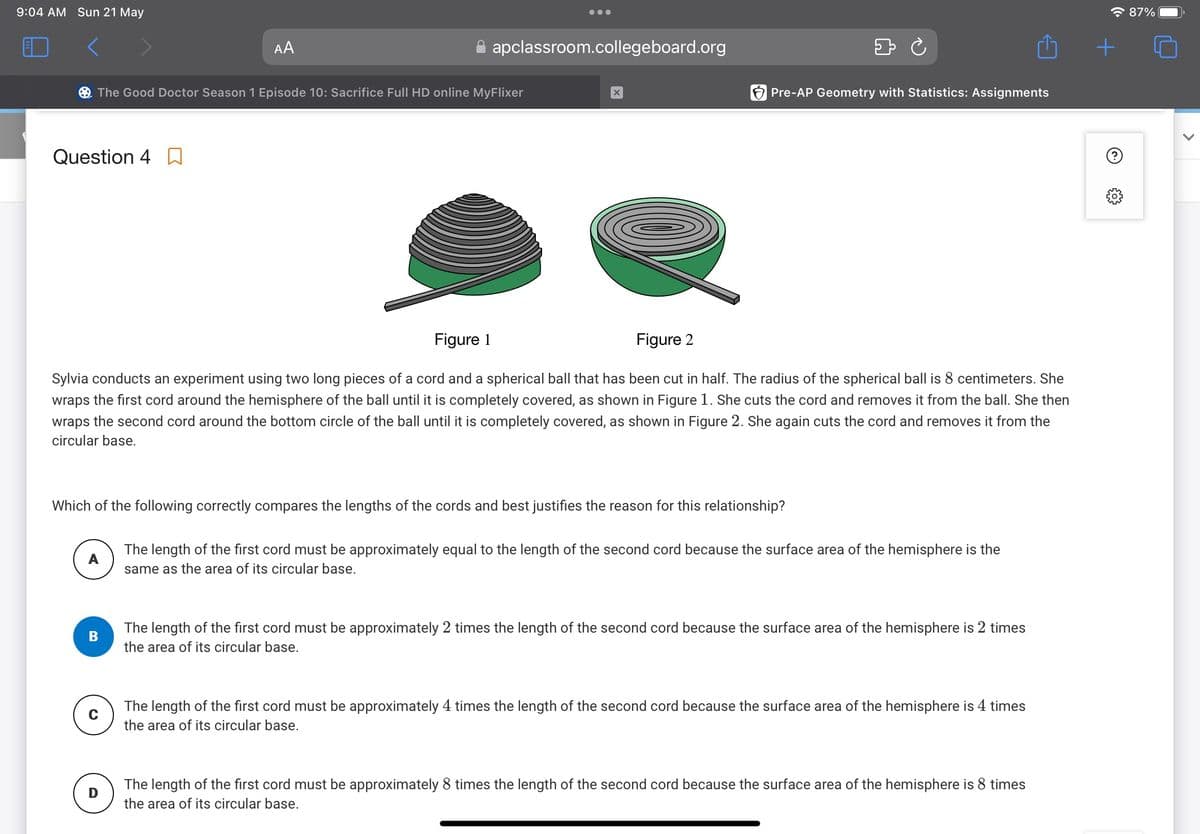Question 40 Figure 1 Figure 2 Sylvia conducts an experiment using two long pieces of a cord and a spherical ball that has been cut in half. The radius of the spherical ball is 8 centimeters. She wraps the first cord around the hemisphere of the ball until it is completely covered, as shown in Figure 1. She cuts the cord and removes it from the ball. She then wraps the second cord around the bottom circle of the ball until it is completely covered, as shown in Figure 2. She again cuts the cord and removes it from the circular base. Which of the following correctly compares the lengths of the cords and best justifies the reason for this relationship? The length of the first cord must be approximately equal to the length of the second cord because the surface area of the hemisphere is the same as the area of its circular base. A B с D The length of the first cord must be approximately 2 times the length of the second cord because the surface area of the hemisphere is 2 times the area of its circular base. The length of the first cord must be approximately 4 times the length of the second cord because the surface area of the hemisphere is 4 times the area of its circular base. The length of the first cord must be approximately 8 times the length of the second cord because the surface area of the hemisphere is 8 times the area of its circular base. 503
Question 40 Figure 1 Figure 2 Sylvia conducts an experiment using two long pieces of a cord and a spherical ball that has been cut in half. The radius of the spherical ball is 8 centimeters. She wraps the first cord around the hemisphere of the ball until it is completely covered, as shown in Figure 1. She cuts the cord and removes it from the ball. She then wraps the second cord around the bottom circle of the ball until it is completely covered, as shown in Figure 2. She again cuts the cord and removes it from the circular base. Which of the following correctly compares the lengths of the cords and best justifies the reason for this relationship? The length of the first cord must be approximately equal to the length of the second cord because the surface area of the hemisphere is the same as the area of its circular base. A B с D The length of the first cord must be approximately 2 times the length of the second cord because the surface area of the hemisphere is 2 times the area of its circular base. The length of the first cord must be approximately 4 times the length of the second cord because the surface area of the hemisphere is 4 times the area of its circular base. The length of the first cord must be approximately 8 times the length of the second cord because the surface area of the hemisphere is 8 times the area of its circular base. 503
Algebra & Trigonometry with Analytic Geometry
13th Edition
ISBN:9781133382119
Author:Swokowski
Publisher:Swokowski
Chapter8: Applications Of Trigonometry
Section8.2: The Law Of Cosines
Problem 7E
Related questions
Question

Transcribed Image Text:9:04 AM Sun 21 May
<
Question 4
AA
The Good Doctor Season 1 Episode 10: Sacrifice Full HD online MyFlixer
●●●
apclassroom.collegeboard.org
B
X
Pre-AP Geometry with Statistics: Assignments
Figure 1
Figure 2
Sylvia conducts an experiment using two long pieces of a cord and a spherical ball that has been cut in half. The radius of the spherical ball is 8 centimeters. She
wraps the first cord around the hemisphere of the ball until it is completely covered, as shown in Figure 1. She cuts the cord and removes it from the ball. She then
wraps the second cord around the bottom circle of the ball until it is completely covered, as shown in Figure 2. She again cuts the cord and removes it from the
circular base.
Which of the following correctly compares the lengths of the cords and best justifies the reason for this relationship?
The length of the first cord must be approximately equal to the length of the second cord because the surface area of the hemisphere is the
same as the area of its circular base.
The length of the first cord must be approximately 2 times the length of the second cord because the surface area of the hemisphere is 2 times
the area of its circular base.
The length of the first cord must be approximately 4 times the length of the second cord because the surface area of the hemisphere is 4 times
the area of its circular base.
The length of the first cord must be approximately 8 times the length of the second cord because the surface area of the hemisphere is 8 times
the area of its circular base.
+
Ⓒ
87%
Expert Solution
This question has been solved!
Explore an expertly crafted, step-by-step solution for a thorough understanding of key concepts.
Step by step
Solved in 3 steps

Recommended textbooks for you

Algebra & Trigonometry with Analytic Geometry
Algebra
ISBN:
9781133382119
Author:
Swokowski
Publisher:
Cengage

Algebra & Trigonometry with Analytic Geometry
Algebra
ISBN:
9781133382119
Author:
Swokowski
Publisher:
Cengage